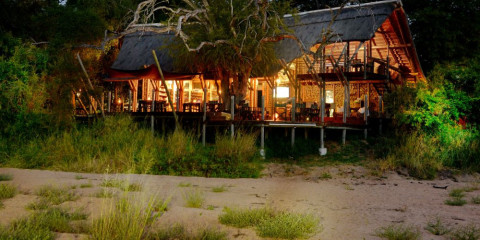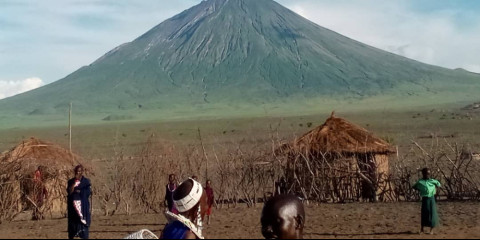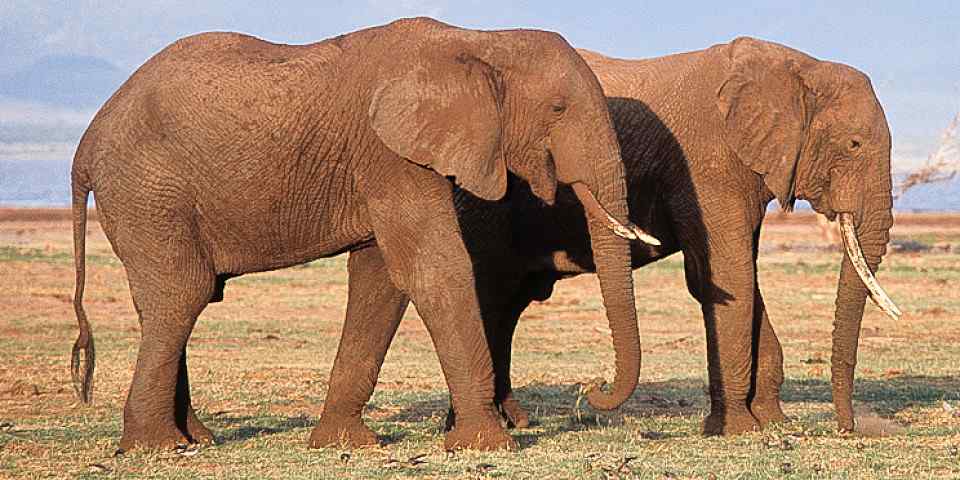Tour Length
Rates in USD $ – Change Currency
Per person, excl. international flightsOperator Rating
Other Tour Features
Filter by Operator
Filter by Accommodation
African Walking Safaris
Walking the wide, open African savannah in the company of an expert guide is the ultimate African safari experience. The guide can point out medicinal plants and tiny creatures and tell you stories of life in the bush. A long walking safari will give you a greater understanding of the ecosystem and its animals and plants than any jeep safari ever could. When you do see animals, it comes with the thrill of knowing that nothing stands between them and you. Altogether, a long walk through the African wilderness might be one of the greatest and most rewarding adventures you embark on.
-
Top Rated Operator

4-Day Rwanda Golden Monkey Trek and Bisoke Hike Trip
$1,596 pp (USD)
Rwanda: Private tour
Mid-range Lodge & HotelYou Visit: Kigali (Start), Volcanoes NP (Gorillas), Mt Bisoke (Virunga Mountains), Kigali (End)

Hermosa Life Tours and Travel
5.0/5 – 208 Reviews
-
Top Rated Operator

6-Day National Parks and Donkey Hike to Lake Natron
$2,155 pp (USD)
Tanzania: Private tourBudgetCamping & Lodge
You Visit: Arusha (Start), Tarangire NP, Ngorongoro Crater, Ngorongoro Highlands, Lake Natron, Arusha (End)

Lion King Adventures
5.0/5 – 1,356 Reviews
-
Top Rated Operator

4-Day Kruger Walking Safari Tour
$2,025 pp (USD)
South Africa: Shared tour (max 10 people per group)LuxuryLodge & Tented Camp
You Visit: Johannesburg (Start), Kruger NP, Johannesburg Airport (End)

MoAfrika Tours
4.9/5 – 4,156 Reviews
-

8-Day Hiking Safari Combined with Wildlife
$2,195 pp (USD)
Tanzania: Private tourBudgetCamping & Tented Camp
You Visit: Arusha (Start), Longido (Town), Mt Longido, Maasai Village (Cultural Village), Lake Natron, Serengeti NP, Arusha (End)

Roko Safaris
4.8/5 – 36 Reviews
-
![5-Day Nyerere Park, Mikumi Park and Udzungwa Waterfalls]()
5-Day Nyerere Park, Mikumi Park and Udzungwa Waterfalls
$1,925 pp (USD)
Tanzania: Private tourBudgetLodge
You Visit: Dar Es Salaam (Start), Serengeti NP, Nyerere NP, Mikumi NP, Dar Es Salaam (End)

Africa Campsbay Tours
5.0/5 – 14 Reviews
-
![3-Day Wildlife Safari in Queen Elizabeth Park]()
3-Day Wildlife Safari in Queen Elizabeth Park
$737 pp (USD)
Uganda: Private tour
Mid-range LodgeYou Visit: Kampala (Start), Queen Elizabeth NP, Kazinga Channel (Queen Elizabeth NP), Igongo Igongo Cultural Centre (Highlight), Kampala (End)

Forever Africa Safari
5.0/5 – 5 Reviews
-
![9-Day Ultimate Walking Safari Adventures Experiences]()
9-Day Ultimate Walking Safari Adventures Experiences
$3,045 pp (USD)
Tanzania: Private tour
Mid-range Lodge & Tented CampYou Visit: Moshi (Start), Foothills of Mt Kilimanjaro, Lake Manyara NP, Serengeti NP, Ngorongoro Crater, Mto wa Mbu (Town), Kilimanjaro Airport (End)

Sunset Adventure Safari
5.0/5 – 156 Reviews
-
![3-Day Golden Monkeys, Batwa Experience & Lake Bunyonyi]()
3-Day Golden Monkeys, Batwa Experience & Lake Bunyonyi
$859 pp (USD)
Uganda: Private tour
Mid-range HotelYou Visit: Entebbe (Start), Mgahinga Gorilla NP (Gorillas), Kampala (City), Entebbe (End)

CPN Consultants
4.9/5 – 25 Reviews
-

5-Day Savannah Wonders - Walking Safari Murchison Falls
$2,305 pp (USD)
Uganda: Private tour
Mid-range CampingYou Visit: Kampala (Start), Murchison Falls NP, Kampala (End)

Bush Wonderers
5.0/5 – 12 Reviews
-
![4-Day Horned Chameleon Tour in Usambara Mountain]()
4-Day Horned Chameleon Tour in Usambara Mountain
$842 pp (USD)
Tanzania: Private tourBudgetLodge & Guest House
You Visit: Dar Es Salaam (Start), Lushoto (Town), Magamba FR, Usambara Mountains (Mountain Range), Dar Es Salaam (End)

Tiem Tours And Safaris
4.9/5 – 8 Reviews
-
![3-Day Luxury Escape to Untamed Beauty]()
3-Day Luxury Escape to Untamed Beauty
$2,858 to $3,333 pp (USD)
Kenya: Private tourLuxuryLodge
You Visit: Nairobi (Start), Samburu NR, Nairobi (End)

The 3Ps Tour and Travel
4.9/5 – 10 Reviews
-
![3-Day Luxury Safari in Serengeti & Ngorongoro Adventure]()
3-Day Luxury Safari in Serengeti & Ngorongoro Adventure
$1,697 pp (USD)
Tanzania: Private tourLuxuryTented Camp
You Visit: Arusha (Start), Serengeti NP, Central Serengeti NP, Ngorongoro Crater, Arusha (End)

Nathan African Safari
4.9/5 – 12 Reviews
-
![3-Day To Explore Arusha National Park and Tarangire NP]()
3-Day To Explore Arusha National Park and Tarangire NP
$739 pp (USD)
Tanzania: Private tour
Mid-range LodgeYou Visit: Moshi (Start), Arusha (City), Arusha NP, Tarangire NP, Arusha (End)

Serengeti Unforgettable Safaris
5.0/5 – 19 Reviews
-
![3-Day Safari Adventure in Lake Mburo National Park]()
3-Day Safari Adventure in Lake Mburo National Park
$638 pp (USD)
Uganda: Private tourBudgetTented Bush Camp
You Visit: Kampala (Start), Lake Mburo NP, Kampala (End)

Rotim Gorilla Tour and Travel
5.0/5 – 1 Reviews
-
![4-Day Rift Valley Hiking Adventure -Suswa-Longonot Etc]()
4-Day Rift Valley Hiking Adventure -Suswa-Longonot Etc
$974 pp (USD)
Kenya: Private tour
Mid-range Tented Camp & HotelYou Visit: Nairobi (Start), Mt Suswa, Mt Longonot, Hell’s Gate NP, Nairobi (End)

Tukutane Kenya Safaris
5.0/5 – 5 Reviews
-
![8-Day Zambia Safari Adventure South Luangwa]()
8-Day Zambia Safari Adventure South Luangwa
$7,278 pp (USD)
Zambia: Private tourLuxuryLodge & Bush Camp
You Visit: Mfuwe (Start), South Luangwa NP, Mfuwe (End)

African Family Safaris
5.0/5 – 16 Reviews
-
![6-Day Fly-in Safari Adventure from Zanzibar]()
6-Day Fly-in Safari Adventure from Zanzibar
$3,003 pp (USD)
Tanzania: Private tour
Mid-range Lodge & Tented CampYou Visit: Zanzibar (Start), Arusha NP, Tarangire NP, Serengeti NP, Ngorongoro Crater, Lake Manyara NP, Zanzibar (End)

Tanzania Joyous Time
4.8/5 – 9 Reviews
-
![4-Day Botswana Walking Safari]()
4-Day Botswana Walking Safari
$3,406 pp (USD)
Botswana & South Africa: Private tour
Mid-range Tented CampYou Visit: Johannesburg (Start), Northern Tuli GR, Johannesburg (End)

Outland Travel
5.0/5 – 7 Reviews
-
![5-Day Hell's Gate-Longonot-Maji Moto Walk in the Wild]()
5-Day Hell's Gate-Longonot-Maji Moto Walk in the Wild
$1,624 pp (USD)
Kenya: Private tourBudgetCamping & Lodge
You Visit: Nairobi (Start), Hell’s Gate NP, Mt Longonot, Maji Moto (Village), Nairobi (End)

Impact Adventure Travel
-
![4-Day Walking Safari Adventure]()
4-Day Walking Safari Adventure
$1,638 pp (USD)
Tanzania: Private tour
Mid-range Lodge & HotelYou Visit: Arusha (Start), Arusha NP, Ngorongoro Crater, Lake Manyara NP, Arusha (End)

Migsam Safaris
6 Questions About Walking Safari Tours

Answered by
Stuart Butler
Stuart Butler is a travel writer and author of many guidebooks for Lonely Planet, Rough Guides and Bradt, including guides to Kenya, Ethiopia, Rwanda and Tanzania. He has traveled widely in Africa, often on foot. He spent five weeks walking across a swathe of southern Kenya with a Maasai friend.› More about Stuart
6 Questions About Walking Safari Tours
 Stuart Butler
Stuart Butler
Why should I choose a walking safari?
“While a classic jeep safari allows you some super-close encounters with large mammals, an African walking safari allows you to see, smell, touch and hear the African wilderness in a way that no jeep safari can. Walking will see you gain a far greater depth of understanding of the African bush. You can see all the little creatures and plants that are so vital in the ecosystem and easily overlooked when traveling in a jeep. You will also be working your muscles by walking, a rare thing on a jeep safari! Combine this closeness to nature with the sheer pleasure of not being jeep-bound for perhaps the most memorable safari holiday you’ll ever go on.”
1What exactly does this type of safari involve?
“There are two different kinds of walking safari. The easiest, and most advertised, is a short bushwalk lasting anything from an hour to half a day. Many safari companies, camps and lodges offer these. They are not always in national parks, where walking is often forbidden. During this type of walking tour, your guide will point out various medicinal plants, the tracks and marks of passing animals and interesting insects. With a little luck, you’ll see larger mammals from a distance. A longer and more challenging multiday trip involves a lot more effort and energy. These kinds of safaris involve camping in remote spots in the bush. Your guide will wake you at dawn with a hot drink. While you eat breakfast, the tents will be dismantled. Walking will start early while it’s still cool and you’ll go at a relaxed pace for a few hours. The guide will point out things of interest and tell you stories from the bush. Lunch will probably be a generous picnic under the shade of an acacia tree. After lunch, there will be another couple of hours’ walking to the night spot. Camp will have already been set up. All you have to do is remove your boots, sit back with a drink and enjoy the sunset. An excellent camp dinner will be served before an early night. You’ll lie in your tent listening to the growls and squeals of the African bush at night. It’s an experience you’ll never forget!”
2What fitness level is required?
“Most walking safaris are little more than gentle walks of no more than an hour or two, along flat ground. For these sorts of tours, also known as bushwalks, you don’t need any exceptional level of fitness. Some safari companies offer much more serious, multiday walking safaris. Again, the walking itself is normally easy, and along flat or gently undulating terrain. Day-to-day distances are moderate as well; 24km to 32km (15mi to 20mi) would be the max. There’s always lots of time to rest and take in the scenery and wildlife. The challenge on such walks is often the sun. Lower altitude parks in particular can get very hot and this heat can drain energy levels quickly. Always try and avoid a walking safari at the hottest time of year. Your guides will be your eyes and ears and constantly alert for wildlife dangers. However, they are not superhuman, and can miss things. Therefore, it’s important that you keep your wits about you as well, which can be tiring on a long, hot walk. Broadly, if you can walk across easy land all day at home then you can likely do it on a multiday African walking safari.”
3What wildlife will I see? How safe is it?
“To animals, humans are bad news and should be given a wide berth. Most large creatures run away at the first indication of people walking through their environment. While you will see large mammals, mostly these sightings are fleeting, or from a distance. Very occasionally, however, we have had some heart-stopping and memorable close encounters on foot with almost all of Africa’s most large animals. And this is where the training of your guide is most valuable. Most usually though, what you will see are all the little things: marching safari ants, sun-bathing lizards, slow tortoises, colorful birds, and more. All these encounters will deepen your understanding of the African savannah. How safe is a walking safari? An experienced guide will reduce your chances of a dangerous wildlife encounter to a bare minimum. A good guide will read the situation, understand the temperament of the animal and calmly and safely remove you from a situation before it develops. It is therefore very important to do your research and choose your operator, and therefore guide, carefully. This particularly applies to budget safaris.”
4What are the typical costs of a walking safari?
“If you’re heading out on a couple of hours’ bushwalk, it’s not likely to cost very much at all. Note that if you’re staying in a top-end camp, bushwalks are usually included in the overall package price. For a multiday walking tour, you’ll naturally pay much more. In most cases, these kinds of safaris tend to be operated by upper-end safari companies and you’ll pay accordingly. Even though you’ll be staying in small tents and roughing it, this kind of safari often costs more than a standard luxury jeep safari. In some areas outside protected zones, local communities can organize longer walking safaris. These are much more affordable and allow more opportunities for genuine cultural interaction, and there’ll still be plenty of wildlife to see.”
5What should I consider when choosing this type of safari?
“If you’re planning on a longer multiday package, it’s important to pick the right time of year for your destination. It’s best to avoid the hotter times of year and the heart of the Wet season. Often the best period is just after the rainy season has finished. The landscapes will be fresh and green, and the temperatures pleasant. If you’re hoping to walk around a national park or other protected area, check in advance that walking safaris are allowed. While many national parks don’t allow walking – Zimbabwe’s Mana Pools National Park is an exception, while guided walks are permitted in some Tanzanian parks – reserves and conservancies often do. You should also consider whether you have the stamina to walk under the burning African sun for several days. Do your research about the possibility of an on-foot encounter with a large animal. Ask your tour operator for advice on how to respond in the unlikely event of this happening. In almost all cases, a walking safari with children in areas rich in large mammals is not likely to be allowed, or simply isn’t safe.”
6
































